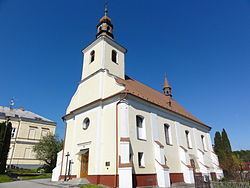District Karviná Postal code 735 72 Area 20.47 km² Local time Wednesday 4:16 PM | First mentioned 1335 Elevation 212 m Population 5,350 (2011) | |
 | ||
Weather 19°C, Wind W at 24 km/h, 43% Humidity | ||
Petrovice u karvin xxii obecn slavnosti
Petrovice u Karviné (1920-1952: Petrovice) (Polish: Piotrowice koło Karwiny , German: Petrowitz bei Freistadt) is a municipality in Karviná District, Moravian-Silesian Region, Czech Republic. It has a population of 5,350 (2011), which makes it the second largest municipality in the Czech Republic without an official town status. 13% of the population are the ethnic Poles, 1,2% are Slovaks and also 1,2% Silesians. Around 22,7% of the population is religious (mostly Roman-Catholic), which is about the double of the national average. It lies on the border with Poland, in the historical region of Cieszyn Silesia. The Petrůvka River flows through the municipality and enters the Olza River in Závada.
Contents
- Petrovice u karvin xxii obecn slavnosti
- Map of 735 72 Petrovice u KarvinC3A9 Czechia
- Z vory a d 97 petrovice u karvin 1 p6515 zaj mav chov n
- Etymology
- History
- Landmarks
- References
Map of 735 72 Petrovice u Karvin%C3%A9, Czechia
The municipality lies five kilometers north of the city centre of Karviná, next to the border with Poland. Formerly independent municipalities of Dolní Marklovice, Prstná and Závada are since 1952 administratively part of Petrovice.
The municipality is the site of the important railway border crossing to Zebrzydowice in Poland and it has also three road border crossings, as well as numerous tourist and bicycle routes border crossings.
Z vory a d 97 petrovice u karvin 1 p6515 zaj mav chov n
Etymology
The name of the village is patronymic in origin, derived from the personal name Petr/Piotr (locally Pieter), ending alternately with typically Slavic -(ow/ov)ice or with German -dorf meaning village.
History
The village was first mentioned in a written document as a seat of a Catholic parish in an incomplete register of Peter's Pence payment from 1335 as villa Petri and as such the parish was one of the oldest in the region. It was again mentioned in the register of Peter's Pence payment from 1447 among the 50 parishes of Teschen deanery as Petirsdorff.
Politically the village belonged initially to the Duchy of Teschen, formed in 1290 in the process of feudal fragmentation of Poland and was ruled by a local branch of Silesian Piast dynasty. In 1327 the duchy became a fee of the Kingdom of Bohemia, which after 1526 became a part of the Habsburg Monarchy.
After the 1540s Protestant Reformation prevailed in the Duchy of Teschen and a local Catholic church was taken over by Lutherans. It was taken from them (as one from around fifty buildings in the region) by a special commission and given back to the Roman Catholic Church on 14 April 1654.
After the Revolutions of 1848 in the Austrian Empire, a modern municipal division was introduced in the re-established Austrian Silesia. The village as a municipality was subscribed at least since 1880 to political district and legal district of Freistadt.
According to the censuses conducted in 1880, 1890, 1900 and 1910 the population of the municipality grew from 1,022 in 1880 to 1,444 in 1910. In terms of the language spoken colloquially the majority were Polish-speakers (at least 82.8% in 1880, at most 91.3% in 1900), accompanied by German-speakers (at least 6.7% in 1900, at most 15% in 1880) and Czech-speakers (at most 2.6% in 1910). In terms of religion, in 1910 the majority were Roman Catholics (1,410 or 97.6%), followed by Protestants (20 or 1.4%) and Jews (14 or 1%). The village was also traditionally inhabited by Silesian Lachs, speaking Cieszyn Silesian dialect.
After World War I, the fall of Austria-Hungary, the Polish–Czechoslovak War and the division of Cieszyn Silesia in 1920, the village became a part of Czechoslovakia. Following the Munich Agreement, in October 1938 together with the Zaolzie region it was invaded by Polish army and annexed by Poland, administratively organised in Frysztat County of Silesian Voivodeship. The village was then annexed by Nazi Germany at the beginning of World War II. After the war it was restored to Czechoslovakia.
